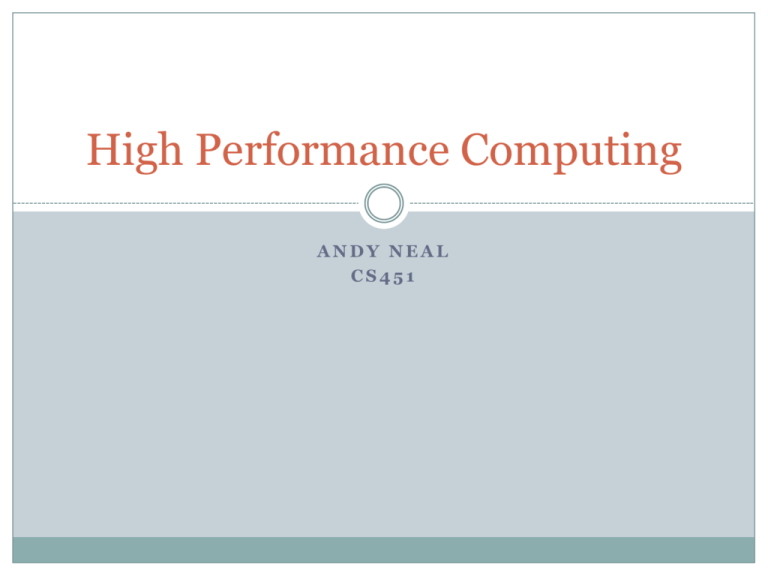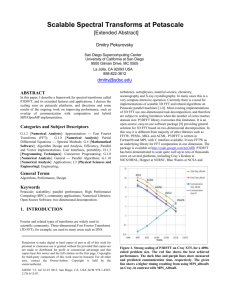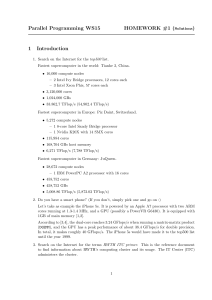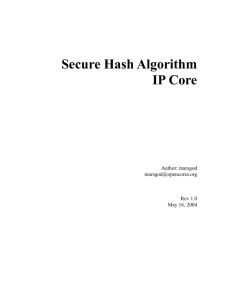High Performance Computing
advertisement

High Performance Computing
ANDY NEAL
CS451
HPC History
Origins in Math and Physics
Ballistics tables
Manhattan Project
Not a coincidence that the CSU datacenter is in the
basement of Engineering E wing – old Physics/Math
wing
FLOPS (Floating point operations per second)
Our primary measure, other operations are irrelevant
Timeline 60-70's
Mainframes
Seymour Cray
CDC
Burroughs
UNIVAC
DEC
IBM
HP
Timeline 80’s
Vector Processors
Designed for operations on data arrays rather than single
elements, first in the 70’s , ended by the 90’s
Scalar Processors
Personal Computers brought commodity CPUs increased
speed and decreased cost
Timeline 90’s
90's-2000's Commodity components / Massively
parallel systems
Beowulf clusters – NASA 1994
"A supercomputer is a device for turning
compute-bound problems into I/O-bound
problems.“
– Ken Batcher
Timeline 2000’s
Jaguar – 2005/2009 Oak Ridge
(224,256 CPU cores 1.75 petaflops)
Our Cray's forefather
Timeline 2000’s
Roadrunner – 2008 Los Alamos
(13,824 CPU cores, 116,640 Cell cores
= 1.7 petaflops)
Timeline 2010’s
Tianhe-1A 2010 - NSC-China
(3,211,264 GPU cores, 86,016 CPU cores
= 4.7 Petaflops)
Caveat of massively Parallel computing
Amdahl's law
A program can only speed up relative to the parallel portion.
Speedup
Execution time for a single Processing Element / execution
time for a given number of parallel PEs
Parallel efficiency
Speedup / PEs
Our Cray XT6m
Our Cray XT6m
(1248 CPU cores, 12 teraflops)
At installation cheapest cost to flops ratio ever built!
Modular system
Will allow for retrofit and
expansion
Cray modular architecture
Cabinets are installed in a 2-d X-Y mesh
1 cabinet contains 3 cages
1 cage contains 8 blades
1 blade contains 4 nodes
1 node contains 24 cores (12 core symmetric CPUs)
Our 1,248 compute cores and all “overhead” nodes
represent 2/3 of one cabinet…
Node types
Boot
Lustrefs
Login
Compute
960 cores devoted to the batch queue
288 cores devoted to interactive use
As a “mid-size” supercomputer (m model) our unit maxes at
13,000 cores…
System architecture
Processor architecture
SeaStar2 interconnect
Hypertransport
Open standard
Packet oriented
Replacement for FSB
Multiprocessor interconnect
Common to AMD architecture (modified)
Bus speeds up to 3.2Ghz DDR
A major differentiation between systems like ours
and common linux compute clusters (where
interconnect happens at the ethernet level).
Filesystem Architecture
Lustre Filesystem
Open standard (owned by Sun/Oracle)
True parallel file system
Still requires interface nodes
Functionally similar to ext4
Currently used by 15 of the 30 fastest HPC systems
Optimized compilers
Uses Cray, PGI, PathScale and GNU
The crap compilers are the only licensed versions we have
installed, they are also notably faster (being used to the
specific architecture)
Supports
C
C++
Fortan
Java (kind of)
Python (soon)
Performance tools
Craypat
Command line performance analysis
Apprentice2
X-window performance analsis
Require instrumented compilation
(Similar to gdb – which also runs here…)
Provides detailed analysis of runtime data, cache misses,
bandwidth use, loop iterations, etc.
Running a job
Nodes are Linux derived (SUSE)
Compute nodes extremely stripped down, only
accessible through aprun
Aprun syntax:
Aprun –n[cores] –d[threads] –N[PE per node] executable
(Batch mode requires additional PBS instructions in the file
but still uses the aprun syntax to execute the binary)
Scheduling – levels
Interactive
Designed for building and testing, job will only run if the
resources are immediately available
Batch
Designed for major computation, jobs are allocated in a
priority system (normally, we are currently running one
queue)
Scheduling - system
Node allocation
Other systems differ here but our Cray does not share nodes
between jobs, goal is to provide maximum available resources
to the currently running job
Compute node time slicing
The compute nodes do time slice, though it’s difficult to see
that from operation as they are only running their own kernel
and their current job
MPI
Every PE runs the same binary
+ More traditional IPC model
+ IP-style architecture (supports multicast!)
+ Versatile (spans nodes, parallel IO!)
+ MPI code will translate between MPI compatible
platforms
- Steeper learning curve
- Will only compile on MPI compatible platforms…
MPI
#include <mpi.h>
using namespace MPI;
main(int argc,char *argv[]) {
int my_rank, nprocs;
Init(argc,argv);
my_rank=COMM_WORLD.Get_rank();
nprocs=COMM_WORLD.Get_size();
if (my_rank == 0) {
...
}
...
}
OpenMP
Essentially pre-built multi-threading
+ Easier learning curve
+ Fantastic timer function
+ Closer to a logical fork operation
+ Runs on anything!
- Limits execution to a single node
- Difficult to tune
- Not yet implemented on GPU based systems (oddly
unless you’re running windows…)
OpenMP
#include <omp.h>
...
double wstart = omp_get_wtime();
#pragma omp parallel
{
#pragma omp for reduction(+:variable_name)
for(int i=0;i<N;++i){
...
}
}
double wstop = omp_get_wtime();
cout << "Dot product time (wtime)" << fixed << wstop - wstart << endl;
MPI / OpenMP Hybridization
These are not mutually exclusive
The reason for –N, –n, and –d flags…
This allows for limiting the number of PEs used on a node, to
optimize cache use and keep from overwhelming the
interconnect
According to ORNL this is the key to fully utilizing
the current Cray architecture
I just haven’t been able to make this work properly yet :)
My MPI codes have always been faster
Programming Pitfalls
A little inefficiency goes a long way…
Given the large number of iterations your code will likely be
running in any minor efficiency fault can quickly become
overwhelming.
CPU time Vs. Wall Clock time
Given that these systems have traditionally been “pay for your
cycles” don’t instrument your code with CPU time, it returns a
cumulative value, even in MPI!
Demo time!
Practices and pitfalls
Watch your function calls and memory usage, malloc is your friend!
Loading/writing data sets is a killer that via Amdahl’s law, if you
can use parallel IO, do it!
Synchronization / data dependency is not your friend, every time
you will have idle PEs.
Future Trends
“Turnkey” supercomputers
GPUs
APUs
OpenDL
CUDA
PVM
Resources
Requesting access – ISTeC requires faculty sponsor
http://istec.colostate.edu/istec_cray/
CrayDocs
http://docs.cray.com/cgi-bin/craydoc.cgi?mode=SiteMap;f=xt3_sitemap
NCSA tutorials
http://www.citutor.org/login.php
MPI-Forum
http://www.mpi-forum.org/
Page for this presentation
http://www.cs.colostate.edu/~neal/
Cray slides used with permission







